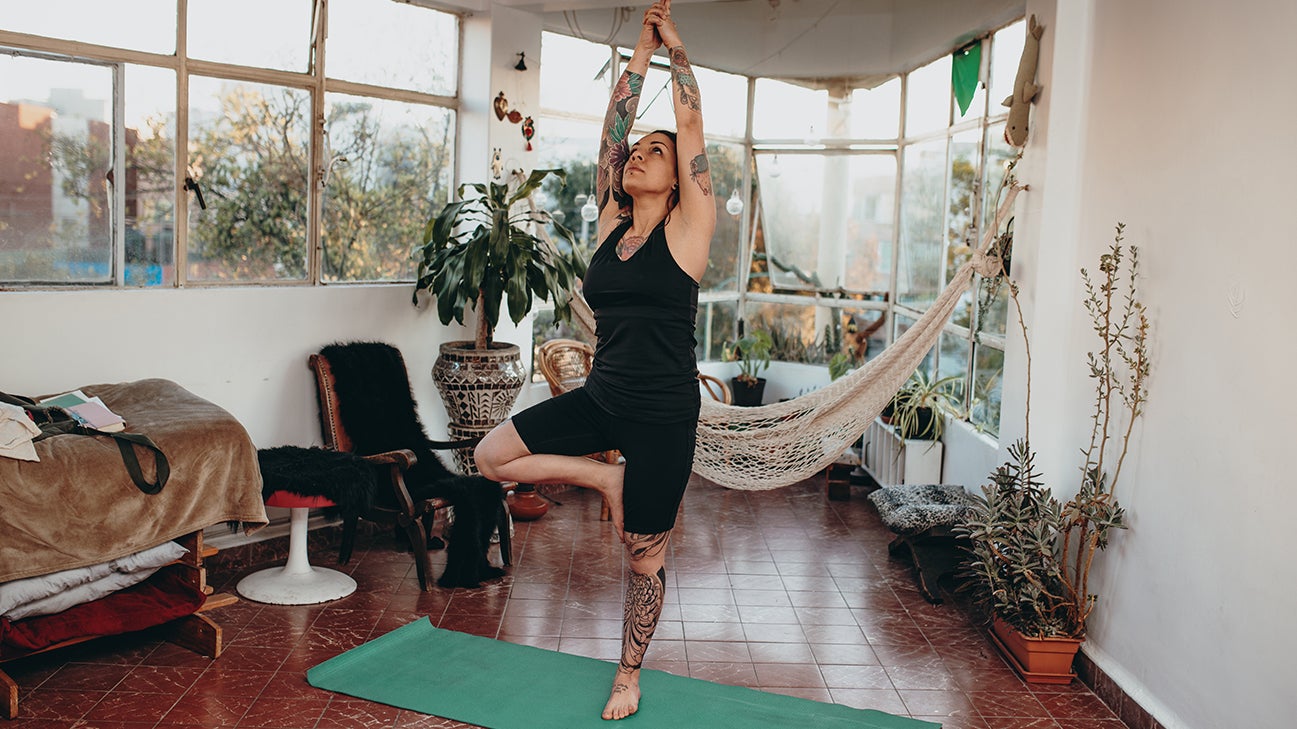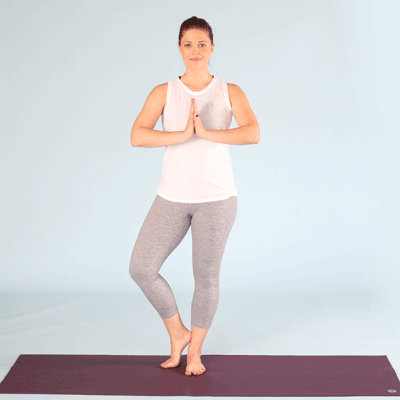Yoga is about balance. Sometimes that means inner balance, sometimes it’s about finding work-life balance. And other times it involves… ya know… literally balancing on one foot. With your other foot up against your knee. Welcome to Tree Pose.
Tree Pose (Vrksasana) 101
Wondering what Tree Pose is? Hold tight, here’s everything you need to know about this complex technique:
- Tree Pose (Vrksasana in Sanskrit) is an intermediate-level yoga position.
- It builds stability and improves posture, while developing your core, lats, and shoulders.
- The pose is harder than it looks. Beginners can try it up against a wall to help them with balance.
- Advanced modifications like a Half-Lotus, Side Plank, and Headstand Tree Poses can keep even the keenest yogi busy for years.
- Due to its complexity, it’s vital to focus on perfecting each aspect of the pose and maintaining stability before combining the techniques.
We’re taking a look at how to reap Tree Pose’s many health benefits. Let’s talk Vrksasana!

Pining for the perfect Tree Pose? Here’s how to do it

Here are the steps to follow for the best Tree Pose form. Don’t worry if you can’t get your nonstanding leg as high as you’d like at first, this isn’t a yoga exercise for beginners. Instead, take your time and the results will come with practice.
Let’s begin:
- Start out standing, with your big toes touching each other and your heels slightly apart.
- Bend your right knee, and place the sole of your right foot against your left thigh.
- Move your hands to your hips for balance.
- Make sure that your standing foot points straight forward.
- Keep your hips square, and avoid rotating your pelvis.
- Draw your right knee backwards as far as it goes while keeping your hips square.
- While holding your legs like that, raise your arms outwards and up until your palms touch above your head.
- Hold for 5 to 10 breaths.
To exit Tree Pose:
- Exhale as you slide your right foot back down to its starting position.
- Return your arms down by your sides.
Now, repeat the pose with your other leg.
Stumped? Improve your Tree Pose with these prep exercises
Not as easy as it looks, is it? Don’t worry, if you’re having a hard time with balance and holding your leg in position, there are some groundwork exercises you can perfect before going full Treebeard.
First off, try the pose next to the wall, using it as a balance aid. That should get you used to the movement in your leg and how to hold your weight on the standing foot. After that, try Supine Tree Pose (Supta Vrksasana):
- Lie on your back, with your arms by your side and your legs together.
- Engage your core, lifting your legs up off the floor a few inches.
- Move your hands up to your hips.
- Without letting your legs lower to the ground, slide your left leg up so it’s flat against your right thigh.
- Hold for 5 to 10 breaths.
- Repeat with the other leg.
Get through 5 to 10 breaths with each leg before you let your legs hit the ground. This should build you up nicely to exercise the control you need for a Standing Tree Pose.
What are the health benefits of Tree Pose in yoga?
Once you fully perfect your Tree Pose, the benefits are going to start making themselves known pretty quickly. These include:
- improved balance
- better posture
- increased awareness of your body
- a stronger core
- more developed shoulders and lats
- greater confidence and mental well-being
You could say that this pose, along with others that target the core and spine, is a perfect antidote to life in the 2020s. We spend a lot of time in office chairs or on the couch, and that sedentary lifestyle can throw up all sorts of health concerns.
Yoga helps us break those habits and replace them with positive behaviors, according to one survey. Alongside the clear health benefits of being more stable and mobile, there’s evidence linking yoga to a significant mental health boost — even during the COVID-19 pandemic.
The key is to link those positive behaviors together ’til they’re more than the sum of their parts. That’s yoga, a holistic approach to unifying mind and body, breath, and motion.
Tree Pose is a step forward from beginner poses — so by the time you’re comfortable with it, your yoga roots will be firmly planted, and the benefits will be blossoming.
Branch out with these Tree Pose modifications
If you’re making the journey from beginner to intermediate yogi, you might want to start looking for some advanced Tree Pose modifications to spice things up. These will challenge you all the way through to expert level.
Bending Tree Pose
Slowly introduce more complexity by adding a toning element to your Tree Pose.
Here’s how:
- Start as normal, standing up with your heels touching and your toes slightly apart.
- Lift the sole of your right foot up against your left thigh.
- Inhale and lift your arms above your head, keeping those hips square.
- Tilt your torso to the right, bringing your right arm to rest on your knee.
- Push your hips left to complete the bend.
- Hold for 5 to 10 breaths.
- Return to the starting position, then repeat with the other leg and direction.
Half-Lotus Tree Pose
Here’s one to bring even more hip-opening into the equation. It also simply looks awesome — exactly what you think of when you imagine a classic yoga pose.
Here’s how to pull it off:
- Stand with your heels together, toes apart, arms down by your sides.
- Lift your right foot flat against your left thigh.
- Inhale, and bring your hands up above your head while your hips remain square.
- Push your right foot up and past your left thigh, until it’s aligned above your left knee.
- Circle your arms down so that your palms touch in front of your face.
- Hold for 5 to 10 breaths.
- Return to starting position, then repeat on the other leg.
This one is a big step up even from the advanced Bending Tree Pose we saw above. Getting that leg up there for step 4 is way harder than it seems. Don’t be discouraged if it takes you a while to feel in control.
Side Plank Tree Pose
When is a tree not a tree? When it’s a plank. Another step up from the original position, this mod introduces more toning and a focus on core strength.
Here’s what to do:
- Begin laying on your right side. Your whole body should be in one straight line with your feet on top of one another.
- Your right palm should be flat against the floor beneath your shoulder, with your elbow bent.
- Slide your left leg up until it’s flat against your right thigh.
- Engage your core, pushing yourself up with your right arm.
- Extend your left arm straight above you. Both arms should form one straight vertical line.
- Hold for 5 to 10 breaths.
- Lower back to the start position, and then repeat the plank on the other side.
Handstand Tree Pose
Hey, you asked for more advanced Tree Pose variations. It doesn’t come more epic than doing one upside down. This expert-level pose tests balance, core strength, and movement control to the max.
Brace yourself, here we go:
- Begin on your hands and knees, facing the wall.
- Arch your body into a bridge and keep walking your feet inward.
- As your feet reach halfway, align your shoulders over your wrists.
- Start transferring your weight forward onto your arms.
- Bend your left knee slightly, then push off with your right leg til you’re upside down.
- Rest your right leg against the wall to balance yourself.
- Bend your left leg and place it flat against your right thigh.
- Hold for 5 to 10 breaths.
- Carefully unbend your left leg and drop back down to the starting position.
- Repeat with the other leg.
Again, this is not a move we recommend for yoga newbies. Don’t attempt it before you’re comfortable with your basic Tree Pose and your upper body strength. We don’t want you landing on your head.
Avoid these yoga mistakes: Don’t go barking up the wrong tree
As you might expect with a more advanced position, Tree Pose has a lot of moving parts and plenty of things that can go awry. Pay special attention to these common errors:
- Don’t let your hip stick out on your standing leg. Keep both sides square with each other at all times.
- Be careful that your standing foot doesn’t wobble off to one side. Make sure it points forward to protect your joints.
- Check that your bent knee isn’t waving around. Keep it steady and pointed out away from its corresponding foot.
- Relax your face, and avoid letting it become a rictus of sweaty effort. Keep it neutral. That’ll help your body relax in the same way.
- Avoid placing your foot on the knee of your standing leg. If you can’t quite bring your foot to your thigh, place it on your shin until you’re comfortable moving it up. But putting pressure on the knee joint risks injury and instability. Trees don’t rock like that.
A challenging way to spruce up your yoga routine
Yoga is a lifetime journey. With Tree Pose, you’re expanding your tool kit with an exercise that you can keep returning to and building on. Even advanced practitioners benefit from uniting its different components into one consistent flow.
Whether you’re in Half-Lotus, Side Plank, or pulling off a full Headstand Tree Pose, there’s a version of it for every level of yogi. As long as you keep the pose stable, and your breathing measured, Tree Pose could help you boost your balance and mental well-being.

0 Commentaires